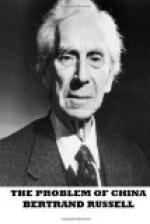There is first the old traditional curriculum, the learning by rote of the classics without explanation in early youth, followed by a more intelligent study in later years. This is exactly like the traditional study of the classics in this country, as it existed, for example, in the eighteenth century. Men over thirty, even if, in the end, they have secured a thoroughly modern education, have almost all begun by learning reading and writing in old-fashioned schools. Such schools still form the majority, and give most of the elementary education that is given. Every child has to learn by heart every day some portion of the classical text, and repeat it out loud in class. As they all repeat at the same time, the din is deafening. (In Peking I lived next to one of these schools, so I can speak from experience.) The number of people who are taught to read by these methods is considerable; in the large towns one finds that even coolies can read as often as not. But writing (which is very difficult in Chinese) is a much rarer accomplishment. Probably those who can both read and write form about five per cent, of the population.
The establishment of normal schools for the training of teachers on modern lines, which grew out of the edict of 1905 abolishing the old examination system and proclaiming the need of educational reform, has done much, and will do much more, to transform and extend elementary education. The following statistics showing the increase in the number of schools, teachers, and students in China are taken from Mr. Tyau’s China Awakened, p. 4:—
1910 1914 1917 1919
Number of Schools 42,444 59,796 128,048 134,000 Number of Teachers 185,566 200,000 326,417 326,000 Number of Students 1,625,534 3,849,554 4,269,197 4,500,000
Considering that the years concerned are years of revolution and civil war, it must be admitted that the progress shown by these figures is very remarkable.
There are schemes for universal elementary education, but so far, owing to the disturbed condition of the country and the lack of funds, it has been impossible to carry them out except in a few places on a small scale. They would, however, be soon carried out if there were a stable government.
The traditional classical education was, of course, not intended to be only elementary. The amount of Chinese literature is enormous, and the older texts are extremely difficult to understand. There is scope, within the tradition, for all the industry and erudition of the finest renaissance scholars. Learning of this sort has been respected in China for many ages. One meets old scholars of this type, to whose opinions, even in politics, it is customary to defer, although they have the innocence and unworldliness of the old-fashioned don. They remind one almost of the men whom Lamb describes in his essay on Oxford in the Vacation—learned, lovable, and sincere,




